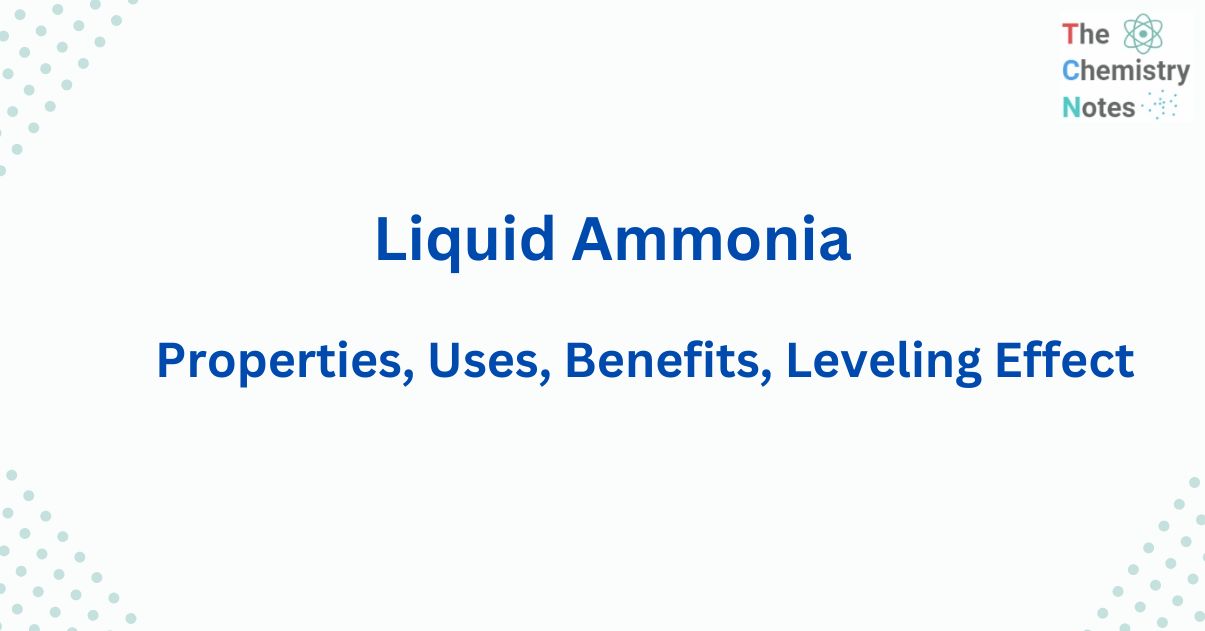
Liquid ammonia is produced by the condensation of ammonia gas. Liquid ammonia is a nonaqueous solvent and it resembles the aqueous system quite closely.
Ammonia most nearly resembles water in all of the qualities that give water its prominent position among solvents. Although it is not as effective as water as a general solvent for salts, it is still the best available. Its ability to dissociate electrolytes is comparable to that of water; some salts conduct electricity even better in ammonia solution than in water solution. It has a role in many compounds similar to that of water in salts containing water of crystallization.
Except for water, its heat of volatilization and probably its association constant are higher than those of any other liquid. For a substance of such a simple composition, its critical temperature, critical pressure, and even its boiling point at atmospheric pressure are remarkably high, as are the corresponding constants in the case of water. It has the same specific heat as water and a lower molecular elevation constant than any other substance for which measurements have been made.
Comparison between liquid ammonia and water
- Self- ionization
Liquid ammonia like water will dissolve a wide variety of salts. Both water and liquid ammonia undergo self-ionization
2 H2O ⇌ H3O+ + OH –
2 NH3 ⇌ NH3+ + NH2 –
- Acid-base neutralization reaction
Substances that produce H3O+ ions in water are acid and ammonium salt is acid in ammonia. Similarly, substances producing OH– in water or NH2– ion in liquid ammonia are bases in that solvent. Thus, an acid-base neutralization reaction occurs in both solvents and phenolphthalein may be used to detect the endpoint in either:
In water:
HCl (acid) + NaOH (base) → NaCl (salt) + H2O ( solvent)
In ammonia
NH4Cl + NaNH2 → NaCl + 2 NH3
- Precipitation reaction
Precipitation reactions occur in both solvents. However, the direction of the reaction is a function of the solvent.
(NH4)2S + Cu++ → 2 NH4 + + Cu2S (in water)
(NH4)2S + Cu++ → 2 NH4 + + Cu2S (in ammonia)
- Amphoteric behaviour
Amphoteric behavior is observed in both solvents. For example, Zn(OH)2 is amphoteric in water and Zn(NH2)2 is amphoteric in ammonia.
- When ammonia melts, its relative volume increases by about 10%, whereas H2O has the opposite sign; ice floats over water. The fact that the liquid state exists over a wider temperature range in H-bonded fluids than in simple fluids is a distinguishing feature.
- Liquid ammonia is an extremely good solvent for the alkali metals and heavier group 2 metals Ca, Sr, and Ba. The metals are very soluble and solutions in liquid ammonia have a conductivity comparable to that of pure metal. These solutions of metals in liquid ammonia are very good reducing agents because of the presence of free electrons.
Liquid ammonia as leveling solvent
The leveling effect, also known as solvent leveling, is the influence of a solvent on the characteristics of acids and bases. A strong acid’s strength is limited (leveled) by the basicity of the solvent. Similarly, the acidity of the solvent balances out the strength of a strong base.
Because these acids ionize in Liq.NH3 to create NH4+ cations, liquid ammonia (NH3) works as a leveling solvent for HCl (Strong acid) and CH3COOH (Weak acid).
HCl + NH3 → Cl – + NH4 +
CH3COOH + NH3 → CH3COO – + NH4 +
Ammonia an effective solvent than water
The features listed below indicate that liquid NH3 is a better solvent (reaction media) than water.
- Redox processes in liquid ammonia are important. It is feasible to work with species that are exceptionally powerful reducing agents. Liquid ammonia is a suitable solvent for many reduction processes due to the powerfully reducing metal-ammonia mixtures. Because strong oxidizing agents reacted with ammonia, they were not utilized in this solvent.
- Liquid NH3 is used to make alkali metal acetylides, M2C2 (by passing C2H2 through alkali metal solutions in liquid NH3). These chemicals are then utilized to make a variety of transition metal acetylides.
- Liquid NH3 contains far more powerful bases than aqueous solutions.
- Because it has less hydrogen bonding than water, liquid NH3 is a better solvent for organic molecules that are more soluble in water.
- Because of its decreased viscosity, liquid NH3 is a better medium for ion transport.
- NH3 has a higher specific heat than water.
- The critical temperature and pressure for liquid NH3 are both high.
- Liquid NH3 is utilized as a preparative media for chemicals that are unstable in water.
Benefits of liquid ammonia as a solvent
- Organic molecules are more soluble in liquid ammonia than in water.
- Alkali metal solutions in liquid ammonia are powerful reducing agents. These solutions are widely employed in inorganic and organic synthesis.
- In liquid NH3, ammonium salts (such as ammonium nitrate) operate as ammonia acids and are useful in preparative chemistry. For example, arsine and silane preparation.
- Solvolytic processes in liquid ammonia are less important than in water, but they are an ideal medium for ammonolytic reactions.
- Far stronger bases can exist in liquid ammonia than in aqueous solution.
Uses of liquid ammonia
- As a nonaqueous solvent, liquid ammonia is widely utilized. In liquid ammonia, alkali metals, heavier alkaline-earth metals, and even some inner transition metals dissolve, generating blue solutions.
- Liquid ammonia can be utilized not only as a transportation fuel but also as a heating fuel (home or industrial). Ammonia can be fractionated to produce hydrogen, which can then be used in fuel cells and other focused uses such as transportation or heat and power generation. Ammonia does not emit any carbon dioxide (CO2), unlike most other liquid fossil fuels (hydrocarbons).
- The volume energy density of liquid ammonia is 11.5 MJ/L, which is almost three times that of diesel and half that of ethanol. Thus, liquid ammonia is more compact than other fuels such as petrol or kerosene, as well as some biofuels such as ethanol or butanol.
- Ammonia has regained prominence in the decarbonization of several specialized industries, most notably maritime transportation, where it is used to replace certain heavy fuels (HFO type), which are renowned for emitting greenhouse gases. During storage, ammonia is less dangerous than hydrogen and releases fewer greenhouse gases than LPG or CNG. As a result, it is regarded as an economically viable fuel for the sea transport sector.
- Ammonia can be utilized to store hydrogen as well. Compared to other storage solutions such as methanol, the hydrogen mass percentage in ammonia is extremely high.
- Liquid ammonia is used to produce hydrogen gas.
- Ammonia pipelines have long been used to deliver liquid ammonia for the fertilizer industry.
- Metal ammonia solutions are good electron donors for the reduction of other chemical species.
References
- https://www.britannica.com/science/ammonia.
- https://doi.org/10.1080/15533170601187474
- https://www.sciencedirect.com/topics/engineering/liquid-ammonia.
- https://www.ncbi.nlm.nih.gov/pmc/articles/PMC9358710/
- https://www.tutorhelpdesk.com/homeworkhelp/Chemistry-/Ammonia-As-A-Better-Solvent-Than-Water-Assignment-Help.html
- http://www.lscollege.ac.in/sites/default/files/e-content/TDC%20PARTII%20%2C%20Liquid%20ammonia%20selfionisation.pdf
